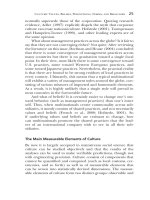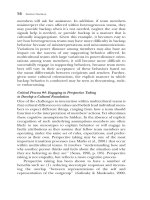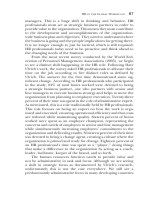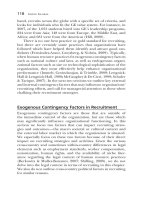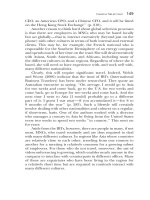working spanish for teachers and education professionals
Bạn đang xem bản rút gọn của tài liệu. Xem và tải ngay bản đầy đủ của tài liệu tại đây (988.4 KB, 238 trang )
working
SPANISH
for
TEACHERS AND
EDUCATION
PROFESSIONALS
Gail Stein
01_095232 ffirs.qxp 3/7/07 2:29 PM Page iii
01_095232 ffirs.qxp 3/7/07 2:29 PM Page vi
working
SPANISH
for
TEACHERS AND
EDUCATION
PROFESSIONALS
01_095232 ffirs.qxp 3/7/07 2:29 PM Page i
01_095232 ffirs.qxp 3/7/07 2:29 PM Page ii
working
SPANISH
for
TEACHERS AND
EDUCATION
PROFESSIONALS
Gail Stein
01_095232 ffirs.qxp 3/7/07 2:29 PM Page iii
Copyright © 2007 by Wiley, Hoboken, NJ
Published by Wiley, Hoboken, NJ
Published simultaneously in Canada
No part of this publication may be reproduced, stored in a retrieval system or trans-
mitted in any form or by any means, electronic, mechanical, photocopying, recording,
scanning or otherwise, except as permitted under Sections 107 or 108 of the 1976
United States Copyright Act, without either the prior written permission of the
Publisher, or authorization through payment of the appropriate per-copy fee to the
Copyright Clearance Center, 222 Rosewood Drive, Danvers, MA 01923, (978)
750-8400, fax (978) 646-8600, or on the web at www.copyright.com. Requests to the
Publisher for permission should be addressed to the Legal Department, Wiley
Publishing, Inc., 10475 Crosspoint Blvd., Indianapolis, IN 46256, (317) 572-3447, fax
(317) 572-4355, or online at />The publisher and the author make no representations or warranties with respect to
the accuracy or completeness of the contents of this work and specifically disclaim all
warranties, including without limitation warranties of fitness for a particular purpose.
No warranty may be created or extended by sales or promotional materials. The advice
and strategies contained herein may not be suitable for every situation. This work is
sold with the understanding that the publisher is not engaged in rendering legal,
accounting, or other professional services. If professional assistance is required, the
services of a competent professional person should be sought. Neither the publisher
nor the author shall be liable for damages arising here from. The fact that an organiza-
tion or Website is referred to in this work as a citation and/or a potential source of fur-
ther information does not mean that the author or the publisher endorses the
information the organization or Website may provide or recommendations it may
make. Further, readers should be aware that Internet Websites listed in this work may
have changed or disappeared between when this work was written and when it is read.
Trademarks: Wiley, the Wiley Publishing logo, Webster’s New World, the Webster’s
New World logo, and related trademarks, are trademarks or registered trademarks of
John Wiley & Sons, Inc. and/or its affiliates. All other trademarks are the property of
their respective owners. Wiley Publishing, Inc. is not associated with any product or
vendor mentioned in this book.
For general information on our other products and services or to obtain technical sup-
port please contact our Customer Care Department within the U.S. at (800) 762-2974,
outside the U.S. at (317) 572-3993 or fax (317) 572-4002.
Wiley also publishes its books in a variety of electronic formats. Some content that
appears in print may not be available in electronic books. For more information about
Wiley products, please visit our web site at www.wiley.com.
Library of Congress Cataloging-in-Publication Data:
Stein, Gail.
Working Spanish for teachers and education professionals / Gail Stein.
p. cm.
ISBN-13 978-0-470-09523-2 (pbk.)
ISBN-10 0-470-09523-7
1. Spanish language—Conversation and phrase books (for school employees)
I. Title.
PC4120.S34S84 2007
468.3'42102437—dc22
2006103072
Printed in the United States of America
10987654321
Book design by Melissa Auciello-Brogan
Book production by Wiley Publishing, Inc. Composition Services
Wiley Bicentennial Logo: Richard J. Pacifico
01_095232 ffirs.qxp 3/7/07 2:29 PM Page iv
This book is dedicated to the memory
of my father, Jack Bernstein, who
will always be with me.
This book is also dedicated to my
husband, Douglas, for his love and patience;
to my wonderful children, Eric, Michael,
and Katherine, for their encouragement and
support; and to my mother, Sara Bernstein,
for always being there for me.
Acknowledgments
Many thanks to Roxane Cerda, my acquisitions editor, who was so
helpful in getting this book off the ground; to Elizabeth Kuball, my
project and copy editor, whose excellent editing skills and sugges-
tions made this book a reality; to Wigberto Rivera, whose technical
expertise and input were invaluable; and to Christina Stambaugh,
Kristie Rees, and all the other people at Wiley Publishing, Inc., for
their patience and help.
01_095232 ffirs.qxp 3/7/07 2:29 PM Page v
01_095232 ffirs.qxp 3/7/07 2:29 PM Page vi
Contents
Chapter 1 Pronunciation Guide 1
Stress and Accents . . . . . . . . . . . . . . . . . . . . . . . . . . . . . . 1
Vowels. . . . . . . . . . . . . . . . . . . . . . . . . . . . . . . . . . . . . . . 2
Diphthongs . . . . . . . . . . . . . . . . . . . . . . . . . . . . . . . . . . . 2
Consonants . . . . . . . . . . . . . . . . . . . . . . . . . . . . . . . . . . . 3
Chapter 2 Numbers 5
Cardinal Numbers . . . . . . . . . . . . . . . . . . . . . . . . . . . . . . 5
Ordinal Numbers . . . . . . . . . . . . . . . . . . . . . . . . . . . . . . . 9
Chapter 3 Time 13
Telling Time. . . . . . . . . . . . . . . . . . . . . . . . . . . . . . . . . . 13
Chapter 4 Days, Months, Dates, Seasons, Holidays,
and the Weather 21
Days . . . . . . . . . . . . . . . . . . . . . . . . . . . . . . . . . . . . . . . 21
Months . . . . . . . . . . . . . . . . . . . . . . . . . . . . . . . . . . . . . 24
Dates. . . . . . . . . . . . . . . . . . . . . . . . . . . . . . . . . . . . . . . 25
The Seasons. . . . . . . . . . . . . . . . . . . . . . . . . . . . . . . . . . 29
Holidays . . . . . . . . . . . . . . . . . . . . . . . . . . . . . . . . . . . . 29
The Weather . . . . . . . . . . . . . . . . . . . . . . . . . . . . . . . . . 31
Chapter 5 Classroom Commands and Rules 35
In the Classroom . . . . . . . . . . . . . . . . . . . . . . . . . . . . . . 35
On the Playground. . . . . . . . . . . . . . . . . . . . . . . . . . . . . 47
Chapter 6 Essential Phrases 51
Greetings . . . . . . . . . . . . . . . . . . . . . . . . . . . . . . . . . . . . 51
Common Courtesy . . . . . . . . . . . . . . . . . . . . . . . . . . . . . 55
Communication . . . . . . . . . . . . . . . . . . . . . . . . . . . . . . . 55
Question Words . . . . . . . . . . . . . . . . . . . . . . . . . . . . . . . 58
Starters and Joiners . . . . . . . . . . . . . . . . . . . . . . . . . . . . 61
In a Few Words . . . . . . . . . . . . . . . . . . . . . . . . . . . . . . . 63
02_095232 ftoc.qxp 3/7/07 3:42 PM Page vii
Good Wishes . . . . . . . . . . . . . . . . . . . . . . . . . . . . . . . . . 68
Words of Encouragement . . . . . . . . . . . . . . . . . . . . . . . . 68
Words of Praise . . . . . . . . . . . . . . . . . . . . . . . . . . . . . . . 69
Chapter 7 Day Care and Pre-K 71
Hours and Costs. . . . . . . . . . . . . . . . . . . . . . . . . . . . . . . 71
Baby Accessories . . . . . . . . . . . . . . . . . . . . . . . . . . . . . . 74
Food Habits. . . . . . . . . . . . . . . . . . . . . . . . . . . . . . . . . . 74
Sleep Habits . . . . . . . . . . . . . . . . . . . . . . . . . . . . . . . . . 76
Bathroom Habits . . . . . . . . . . . . . . . . . . . . . . . . . . . . . . 77
Clothing . . . . . . . . . . . . . . . . . . . . . . . . . . . . . . . . . . . . 79
Developmental Skills. . . . . . . . . . . . . . . . . . . . . . . . . . . . 80
Toys and Activities . . . . . . . . . . . . . . . . . . . . . . . . . . . . . 81
Moods and Behavior . . . . . . . . . . . . . . . . . . . . . . . . . . . 83
Illnesses and Accidents . . . . . . . . . . . . . . . . . . . . . . . . . . 85
Chapter 8 Registration 89
Personal Information . . . . . . . . . . . . . . . . . . . . . . . . . . . 89
Physical Descriptions . . . . . . . . . . . . . . . . . . . . . . . . . . . 94
Personality Traits. . . . . . . . . . . . . . . . . . . . . . . . . . . . . . . 95
Type of School . . . . . . . . . . . . . . . . . . . . . . . . . . . . . . . . 97
Family Members . . . . . . . . . . . . . . . . . . . . . . . . . . . . . . 97
Parental Contact . . . . . . . . . . . . . . . . . . . . . . . . . . . . . . 100
Chapter 9 In, Around, and After School 103
People. . . . . . . . . . . . . . . . . . . . . . . . . . . . . . . . . . . . . 103
Classroom Fixtures . . . . . . . . . . . . . . . . . . . . . . . . . . . . 107
Locations . . . . . . . . . . . . . . . . . . . . . . . . . . . . . . . . . . . 109
Giving Directions . . . . . . . . . . . . . . . . . . . . . . . . . . . . . 112
Extracurricular Activities . . . . . . . . . . . . . . . . . . . . . . . . 115
Chapter 10 Medical 121
Parts of the Body . . . . . . . . . . . . . . . . . . . . . . . . . . . . . 121
Accidents . . . . . . . . . . . . . . . . . . . . . . . . . . . . . . . . . . . 123
Illnesses and Medical Conditions . . . . . . . . . . . . . . . . . . 127
Signs and Symptoms . . . . . . . . . . . . . . . . . . . . . . . . . . 132
Abuse . . . . . . . . . . . . . . . . . . . . . . . . . . . . . . . . . . . . . 134
Working Spanish for Teachers and Education Professionalsviii
02_095232 ftoc.qxp 3/7/07 3:42 PM Page viii
Nutritional Requirements . . . . . . . . . . . . . . . . . . . . . . . 136
Emergencies . . . . . . . . . . . . . . . . . . . . . . . . . . . . . . . . 140
Chapter 11 Content Areas 143
School Subjects . . . . . . . . . . . . . . . . . . . . . . . . . . . . . . 143
In English Class . . . . . . . . . . . . . . . . . . . . . . . . . . . . . . 147
About Bilingual Education and ESL . . . . . . . . . . . . . . . . 149
In History and Geography Class. . . . . . . . . . . . . . . . . . . 149
In Math Class . . . . . . . . . . . . . . . . . . . . . . . . . . . . . . . . 151
In Science Class . . . . . . . . . . . . . . . . . . . . . . . . . . . . . . 154
In Computer Science. . . . . . . . . . . . . . . . . . . . . . . . . . . 157
In Art Class . . . . . . . . . . . . . . . . . . . . . . . . . . . . . . . . . 158
In Music Class . . . . . . . . . . . . . . . . . . . . . . . . . . . . . . . 158
In Physical Education Class . . . . . . . . . . . . . . . . . . . . . . 159
Academic Skills . . . . . . . . . . . . . . . . . . . . . . . . . . . . . . 159
School Supplies . . . . . . . . . . . . . . . . . . . . . . . . . . . . . . 161
Chapter 12 Expectations and Consequences 165
Dress Codes . . . . . . . . . . . . . . . . . . . . . . . . . . . . . . . . . 165
Class Participation . . . . . . . . . . . . . . . . . . . . . . . . . . . . 169
Lateness. . . . . . . . . . . . . . . . . . . . . . . . . . . . . . . . . . . . 171
Excessive Absence . . . . . . . . . . . . . . . . . . . . . . . . . . . . 172
Cutting Class . . . . . . . . . . . . . . . . . . . . . . . . . . . . . . . . 175
Homework. . . . . . . . . . . . . . . . . . . . . . . . . . . . . . . . . . 176
Behavior and Interaction with Peers. . . . . . . . . . . . . . . . 178
Attitude. . . . . . . . . . . . . . . . . . . . . . . . . . . . . . . . . . . . 180
Work Habits. . . . . . . . . . . . . . . . . . . . . . . . . . . . . . . . . 181
Discipline. . . . . . . . . . . . . . . . . . . . . . . . . . . . . . . . . . . 183
Grades and Promotion . . . . . . . . . . . . . . . . . . . . . . . . . 187
Conferences . . . . . . . . . . . . . . . . . . . . . . . . . . . . . . . . . 189
On the Phone . . . . . . . . . . . . . . . . . . . . . . . . . . . . . . . 191
Chapter 13 The Special-Needs Student 195
Special Needs . . . . . . . . . . . . . . . . . . . . . . . . . . . . . . . 195
School Offerings. . . . . . . . . . . . . . . . . . . . . . . . . . . . . . 199
Special Education . . . . . . . . . . . . . . . . . . . . . . . . . . . . . 200
Parents’ Rights . . . . . . . . . . . . . . . . . . . . . . . . . . . . . . . 209
A Child’s Progress. . . . . . . . . . . . . . . . . . . . . . . . . . . . . 210
Contents ix
02_095232 ftoc.qxp 3/7/07 3:42 PM Page ix
Chapter 14 Planning for the Future 217
Promotion and Graduation Requirements. . . . . . . . . . . . 217
Applying for a Job . . . . . . . . . . . . . . . . . . . . . . . . . . . . 219
Applying to a College. . . . . . . . . . . . . . . . . . . . . . . . . . 222
Working Spanish for Teachers and Education Professionalsx
02_095232 ftoc.qxp 3/7/07 3:42 PM Page x
Chapter
1
Pronunciation Guide
S
panish sounds are relatively easy to master because they resem-
ble the sounds of English, and because Spanish letters and let-
ter combinations are generally pronounced phonetically (unlike
English letters and letter combinations, which may be pronounced
in a variety of ways—“bar” versus “bat”; “cough” versus “though”).
When speaking Spanish, if you stress the wrong syllable or mispro-
nounce a word, don’t worry—you’ll still be understood and your
efforts will be appreciated.
Stress and Accents
The rules for stress in Spanish are:
1. If the word ends in a vowel (a, e, i, o, u), n, or s, stress the next
to the last syllable:
amigo (friend) ah-mee-goh
examen (test, exam) ehk-sah-mehn
muchachos (boys) moo-chah-chohs
2. If the word ends in a consonant other than n or s, stress the
last syllable:
papel (paper) pah-pehl
profesor (teacher) proh-feh-sohr
3. Any exceptions to the above rules have accent marks to help
you place the stress correctly:
composición kohm-poh-see-see-yohn
(composition)
lápiz (pencil) lah-pees
1
03_095232 ch01.qxp 3/7/07 3:42 PM Page 1
The three accent marks in Spanish are:
• ´ This accent goes above a vowel to indicate that the sylla-
ble is stressed:
álgebra (algebra) ahl-heh-brah
inglés (English) een-glehs
• ~ The tilde goes above an n to produce the ny sound in the
word “union”:
año (year) ah-nyoh
mañana (tomorrow) mah-nyah-nah
• ¨ The umlaut is used on the letter u in diphthongs (combi-
nations of vowels) to show that each vowel is pronounced
separately:
vergüenza (shame) behr-goo-ehn-sah
Vowels
The sound of each Spanish vowel consistently remains the same
and is pronounced the way it is written. If you have to spell a word,
the pronunciation of the vowels is in parentheses.
Vowels
Vowel Sound Example Pronunciation
aahfalta (mistake) fahl-tah
eehexcelente (excellent) ehk-seh-lehn-teh
ieelibro (book) lee-broh
oohocho (eight) oh-choh
uoouno (one) oo-noh
Diphthongs
A diphthong is generally (but not always) a combination of one
weak vowel (i or u) and one strong vowel (a, e, or o) that appear in
the same syllable.
Working Spanish for Teachers and Education Professionals2
03_095232 ch01.qxp 3/7/07 3:42 PM Page 2
Diphthongs
Diphthong Sound Example Pronunciation
ai ah-ee aire (air) ah-ee-reh
au ah-oo autor (author) ah-oo-tohr
ay ah-ee hay (there is/are) ah-ee
ei eh-ee seis (six) seh-ees
eu eh-oo Europa (Europe) eh-oo-roh-pah
ia ee-ah seria (serious) seh-ree-ah
ie ee-eh siesta (nap) see-ehs-tah
io ee-oh estudio (study) ehs-too-dee-oh
iu ee-oo ciudad (city) see-oo-dahd
oi oh-ee oigo (I hear) oh-ee-goh
ua oo-ah cuatro (four) koo-ah-troh
ue oo-eh bueno (good) boo-eh-noh
ui oo-ee cuidado (care) koo-ee-dah-doh
uo oo-oh cuota (quota) koo-oh-tah
Consonants
Most Spanish consonants are pronounced in the same way as
they are pronounced in English. If you have to spell a word, the
pronunciation of the consonants is in parentheses.
Consonants
Consonant Sound Example Pronunciation
b (beh) b bien (well) bee-ehn
c (seh)+ e or i s cinco (five) seen-koh
c (seh)+ a, o, u k banco (bench) bahn-koh
ch (cheh) ch leche (milk) leh-cheh
d (deh) d dama (lady) dah-mah
f (eh-feh) f fiesta (party) fee-ehs-tah
g (heh)+ e or i h general (general) heh-neh-rahl
continued
Pronunciation Guide 3
03_095232 ch01.qxp 3/7/07 3:42 PM Page 3
Consonant Sound Example Pronunciation
g (heh)+ a, o, u g goma (eraser) goh-mah
h (ah-cheh) silent hora (hour) oh-rah
j (hoh-tah) h junio (June) hoo-nee-oh
k (kah) k kilo (kilo) kee-loh
l (eh-leh) l sala (room) sah-lah
ll (eh-yeh) y silla (chair) see-yah
m (eh-meh) m madre (mother) mah-dreh
n (eh-neh) n nombre (name) nohm-breh
p (peh) p padre (father) pah-dreh
q (koo) k quince (fifteen) keen-seh
r (eh-reh) (rolled) r tarea (homework) tah-reh-ah
rr (eh-rreh) rr regla (ruler) rreh-glah
(rolled a lot)*
rr (rolled a lot)* rr carro (car) kah-rroh
s (eh-seh) s frase (sentence) frah-seh
t (teh) t tiza (chalk) tee-sah
v (beh) soft b veinte (twenty) beh-een-teh
w (doble beh) w western (western) wehs-tehrn
x (eh-kees) ks exacto (exact) ehk-sahk-toh
y (ee gree-eh-gah) y yo (I) yoh
z (seh-tah) s zoo (zoo) soh
* The r is rolled two or three times when it appears at the beginning of a word or when
it is doubled within a word.
Working Spanish for Teachers and Education Professionals4
03_095232 ch01.qxp 3/7/07 3:42 PM Page 4
Chapter
2
Numbers
Note:
1. Letters or words in brackets are used when using the
familiar you [tú] form.
2. When speaking to more than one adult, Ud. (you, sin-
gular) becomes Uds. (you, plural) and an n is added
to the conjugated verb form.
3. The formal you form is expressed in the same way as
the third-person singular él (he) and ella (she) forms.
Cardinal Numbers
Cardinal numbers are used for counting.
Number Spanish Pronunciation
0 cero seh-roh
1 uno oo-noh
2 dos dohs
3 tres trehs
4 cuatro koo-ah-troh
5 cinco seen-koh
6 seis seh-ees
7 siete see-eh-teh
8 ocho oh-choh
9 nueve noo-eh-beh
10 diez dee-ehs
11 once ohn-seh
12 doce doh-seh
5
04_095232 ch02.qxp 3/7/07 3:42 PM Page 5
Number Spanish Pronunciation
13 trece treh-seh
14 catorce kah-tohr-seh
15 quince keen-seh
16 dieciséis (diez y seis) dee-ehs-ee-seh-ees
17 diecisiete (diez y siete) dee-ehs-ee-see-eh-teh
18 dieciocho (diez y ocho) dee-ehs-ee-oh-choh
19 diecinueve (diez y nueve) dee-ehs-ee-noo-eh-beh
20 veinte beh-een-teh
21 veintiuno (veinte y uno) beh-een-tee-oo-noh
22 veintidós (veinte y dos) beh-een-tee-dohs
23 veintitrés (veinte y tres) beh-een-tee-trehs
24 veinticuatro (veinte y beh-een-tee-koo-ah-troh
cuatro)
25 veinticinco (veinte y cinco) beh-een-tee-seen-koh
26 veintiséis (veinte y seis) beh-een-tee-seh-ees
27 veintisiete (veinte y siete) beh-een-tee-see-eh-teh
28 veintiocho (veinte y ocho) beh-een-tee-oh-choh
29 veintinueve (veinte y beh-een-tee-noo-eh-beh
nueve)
30 treinta treh-een-tah
From 30 on, compound numbers are always written separately:
Number Spanish Pronunciation
31 treinta y uno treh-een-tah ee oo-noh
40 cuarenta koo-ah-rehn-tah
45 cuarenta y cinco koo-ah-rehn-tah ee seen-koh
50 cincuenta seen-koo-ehn-tah
60 sesenta seh-sehn-tah
70 setenta seh-tehn-tah
80 ochenta oh-chehn-tah
90 noventa noh-behn-tah
100 ciento (cien) see-ehn-toh (see-ehn)
101 ciento uno see-ehn-toh oo-noh
200 doscientos dohs-see-ehn-tohs
500 quinientos kee-nee-ehn-tohs
1000 mil meel
2000 dos mil dohs meel
100.000 cien mil see-ehn meel
1.000.000 un millón oon meel-yohn
Working Spanish for Teachers and Education Professionals6
04_095232 ch02.qxp 3/7/07 3:42 PM Page 6
Number Spanish Pronunciation
2.000.000 dos millones dohs meel-yoh-nehs
1.000.000.000 mil millones meel meel-yoh-nehs
2.000.000.000 dos mil millones dos meel meel-yoh-nehs
When you want to use Spanish cardinal numbers, remember to
do the following:
• Use uno only when counting. Uno becomes un before a mas-
culine noun and una before a feminine noun:
uno, dos, tres . . . one, two, three . . .
un hombre y una a man and a woman
mujer
treinta y un libros thirty-one books
veintiuna páginas twenty-one pages
• Use the conjunction y (and) only for numbers between 16
and 99. Note, however, that compound numbers between
21 and 29 are frequently written as one word (see above):
sesenta y dos 62
but
ciento sesenta y dos 162
• Show agreement with a feminine noun in compounds of
ciento (for example, doscientos, trescientos):
doscientos pesos two hundred pesos
trescientas pesetas three hundred pesetas
• Use cien before nouns and before the numbers mil and mil-
lones. Before all other numbers, use ciento:
cien alumnos one hundred students
cien mil personas one hundred thousand people
cien millones de one hundred million inhabitants
habitantes
ciento dos páginas one hundred and two pages
• Use un before millón but not before cien(to) or mil. When a
noun follows millón, put de between millón and the noun:
cien libros one hundred books
ciento noventa one hundred ninety pages
páginas
mil personas one thousand people
un millón de dólares a million dollars
Numbers 7
04_095232 ch02.qxp 3/7/07 3:42 PM Page 7
• Use the following words to express common arithmetic
functions:
y plus (+)
menos minus (–)
por times (×)
dividido por divided by (÷)
son equals (=)
When reading Spanish numbers, keep in mind that the
Spanish-speaking world writes numbers differently from the way
Americans do. The number 1 has a little hook on top, which
makes it look like a 7. So, to distinguish a 1 from a 7, a line is put
through the 7, to look like this: 7.
In numerals and decimals, Spanish uses commas where English
uses periods, and vice versa:
English Spanish
8,000 8.000
.75 0,75
$16.25 $16,25
The Spanish-speaking world reverses the numerical order to
express dates:
Date English Spanish
August 7, 2006 8/7/06 7/8/06
Using Cardinal Numbers
We are on page 156.
Estamos en la página ciento cincuenta y seis.
ehs-tah-mohs ehn lah pah-hee-nah see-ehn-toh seen-koo-ehn-tah ee seh-ees
The book costs $32.
El libro cuesta treinta y dos dólares.
ehl lee-broh koo-ehs-tah treh-een-tah ee dohs doh-lah-rehs
You (He/She) received 95 on the test.
Recibió noventa y cinco en el examen.
rreh-see-bee-oh noh-behn-tah ee seen-koh ehn ehl ehk-sah-mehn
You are (He/She is) missing six homeworks.
Le faltan seis tareas.
leh fahl-tahn seh-ees tah-reh-ahs
Working Spanish for Teachers and Education Professionals8
04_095232 ch02.qxp 3/7/07 3:42 PM Page 8
You were (He/She was) absent 24 times.
Estuvo ausente veinticuatro veces.
ehs-too-boh ah-oo-sehn-teh beh-een-tee-koo-ah-troh beh-sehs
You were (He/She was) late ten times, often by 30 minutes or more.
Llegó tarde diez veces, frecuentemente con treinta minutos de
retraso o más.
yeh-goh tahr-deh dee-ehs beh-sehs; freh-koo-ehn-teh-mehn-teh kohn treh-een-
tah mee-noo-tohs deh rreh-trah-soh oh mahs
You have (He/She has) to spend at least an hour a day studying.
Tiene que pasar por lo menos una hora al día estudiando.
tee-eh-neh keh pah-sar pohr loh meh-nos oo-nah oh-rah ahl dee-ah ehs-too-
dee-ahn-doh
You need (He/She needs) three notebooks for the class.
Necesita tres cuadernos para la clase.
neh-seh-see-tah trehs koo-ah-dehr-nohs pah-rah lah klah-seh
My telephone number at school is 555-6789.
Mi número de teléfono en la escuela es cinco, cinco, cinco,
seis, siete, ocho, nueve.
mee noo-meh-roh deh teh-leh-foh-noh ehn lah ehs-koo-eh-lah ehs seen-koh,
seen-koh, seen-koh, seh-ees, see-eh-teh, oh-choh, noo-eh-beh
Our class is going to take a trip on May 3rd.
Nuestra clase irá de excursión el tres de mayo.
noo-ehs-trah klah-seh ee-rah deh ehks-koor-see-yohn ehl trehs deh mah-yoh
We will leave at three o’clock.
Saldremos a las tres.
sahl-dreh-mohs ah lahs trehs
Ordinal Numbers
Ordinal numbers allow you to express numbers in a series.
Ordinal Spanish Pronunciation
1st primero pree-meh-roh
2nd segundo seh-goon-doh
3rd tercero tehr-seh-roh
4th cuarto koo-ahr-toh
5th quinto keen-toh
6th sexto sehks-toh
Numbers 9
04_095232 ch02.qxp 3/7/07 3:42 PM Page 9
Ordinal Spanish Pronunciation
7th séptimo sehp-tee-moh
8th octavo ohk-tah-boh
9th noveno noh-beh-noh
10th décimo deh-see-moh
When you want to use Spanish ordinal numbers, remember to
do the following:
• Use Spanish ordinal numbers only through the tenth. After
that, use cardinal numbers:
el séptimo grado the seventh grade
el siglo veintiuno the 21st century
• Change the final o of the masculine form to a for agreement
with a feminine noun:
el sexto día the sixth day
la quinta semana the fifth week
• Drop the final o before a masculine singular noun when
using primero and tercero:
el primer año the first year
el tercer piso the third floor
but
el siglo tercero the third century
• Use primero in dates to express the first of a month:
el primero de enero January 1st
• Use cardinal numbers before ordinal numbers:
los tres primeros the first three chapters
capítulos
When writing, keep in mind that Spanish ordinal numbers are
abbreviated as follows:
Ordinal Number Spanish Abbreviation
1st primero (masculine) 1
o
primera (feminine) 1
a
primer (masculine 1
er
before singular noun)
2nd segundo (masculine) 2
o
segunda (feminine) 2
a
Working Spanish for Teachers and Education Professionals10
04_095232 ch02.qxp 3/7/07 3:42 PM Page 10
Ordinal Number Spanish Abbreviation
3rd tercero (masculine) 3
o
tercera (feminine) 3
a
tercer (masculine before 3
er
singular noun)
4th cuarto (masculine) 4
o
cuarta (feminine) 4
a
5th quinto (masculine) 5
o
quinta (feminine) 5
a
6th sexto (masculine) 6
o
sexta (feminine) 6
a
7th séptimo (masculine) 7
o
séptima (feminine) 7
a
8th octavo (masculine) 8
o
octava (feminine) 8
a
9th noveno (masculine) 9
o
novena (feminine) 9
a
10th décimo (masculine) 10
o
décima (feminine) 10
a
Using Ordinal Numbers
There is a test on March 1st.
Hay un examen el primero de marzo.
ah-ee oon ehk-sah-mehn ehl pree-meh-roh deh mahr-soh
That office is on the first floor.
Esa oficina está en el primer piso.
eh-sah oh-fee-see-nah ehs-tah ehn ehl pree-mehr pee-soh
That classroom is on the third floor.
Ese salón de clase está en el tercer piso.
eh-seh sah-lohn deh klah-seh ehs-tah ehn ehl tehr-sehr pee-soh
You have (He/She has) passed the sixth grade.
Ha aprobado el sexto grado.
ah ah-proh-bah-doh ehl sehks-toh grah-doh
You (He/[She]) came in fifth in the competition.
Terminó quinto (quinta) en la competición.
tehr-mee-noh keen-toh (keen-tah) ehn lah kohm-peh-tee-see-ohn
Numbers 11
04_095232 ch02.qxp 3/7/07 3:42 PM Page 11
You (He/She) won second prize.
Ganó el segundo premio.
gah-noh ehl seh-goon-doh preh-mee-oh
You were (He/[She] was) first in the class.
Fue primero (primera) en la clase.
foo-eh pree-meh-roh (pree-meh-rah) ehn lah klah-seh
That wasn’t the first time you were (he/she was) late.
No era la primera vez que llegó con retraso.
noh eh-rah lah pree-meh-rah behs keh yeh-goh kohn rreh-trah-soh
Working Spanish for Teachers and Education Professionals12
04_095232 ch02.qxp 3/7/07 3:42 PM Page 12
Chapter
3
Time
Note:
1. Letters or words in brackets are used when using the
familiar you [tú] form.
2. When speaking to more than one adult, Ud. (you, sin-
gular) becomes Uds. (you, plural) and an n is added
to the conjugated verb form.
3. The formal you form is expressed in the same way as
the third-person singular él (he) and ella (she) forms.
Telling Time
What time is it?
¿Qué hora es?
keh oh-rah ehs
It is one o’clock.
Es la una.
ehs lah oo-nah
It is two (three) o’clock.
Son las dos (tres).
sohn lahs dohs (trehs)
At what time . . . ?
A qué hora . . . ?
ah keh oh-rah
13
05_095232 ch03.qxp 3/7/07 3:42 PM Page 13





